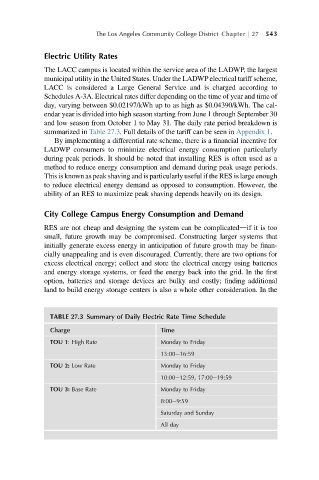Page 574 - Sustainable Cities and Communities Design Handbook
P. 574
The Los Angeles Community College District Chapter j 27 543
Electric Utility Rates
The LACC campus is located within the service area of the LADWP, the largest
municipal utility in the United States. Under the LADWP electrical tariff scheme,
LACC is considered a Large General Service and is charged according to
Schedules A-3A. Electrical rates differ depending on the time of year and time of
day, varying between $0.02197/kWh up to as high as $0.04390/kWh. The cal-
endar year is divided into high season starting from June 1 through September 30
and low season from October 1 to May 31. The daily rate period breakdown is
summarized in Table 27.3. Full details of the tariff can be seen in Appendix 1.
By implementing a differential rate scheme, there is a financial incentive for
LADWP consumers to minimize electrical energy consumption particularly
during peak periods. It should be noted that installing RES is often used as a
method to reduce energy consumption and demand during peak usage periods.
This is known as peak shaving and is particularly useful if the RES is large enough
to reduce electrical energy demand as opposed to consumption. However, the
ability of an RES to maximize peak shaving depends heavily on its design.
City College Campus Energy Consumption and Demand
RES are not cheap and designing the system can be complicateddif it is too
small, future growth may be compromised. Constructing larger systems that
initially generate excess energy in anticipation of future growth may be finan-
cially unappealing and is even discouraged. Currently, there are two options for
excess electrical energy; collect and store the electrical energy using batteries
and energy storage systems, or feed the energy back into the grid. In the first
option, batteries and storage devices are bulky and costly; finding additional
land to build energy storage centers is also a whole other consideration. In the
TABLE 27.3 Summary of Daily Electric Rate Time Schedule
Charge Time
TOU 1: High Rate Monday to Friday
13:00e16:59
TOU 2: Low Rate Monday to Friday
10:00e12:59, 17:00e19:59
TOU 3: Base Rate Monday to Friday
8:00e9:59
Saturday and Sunday
All day

